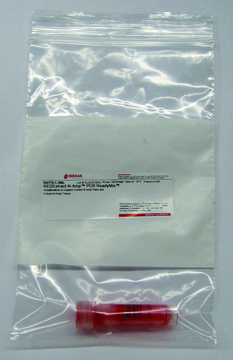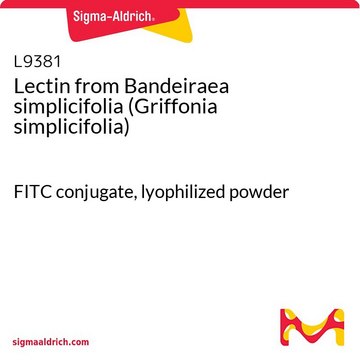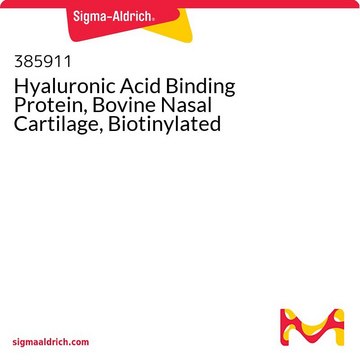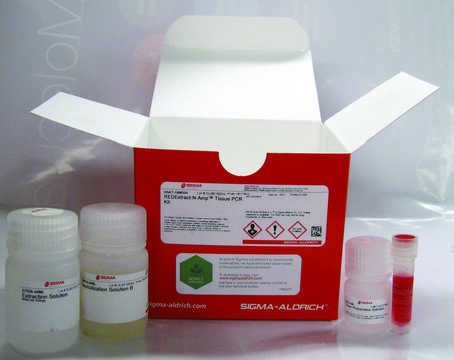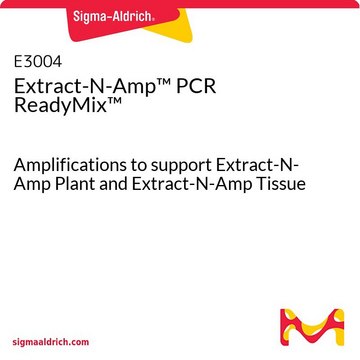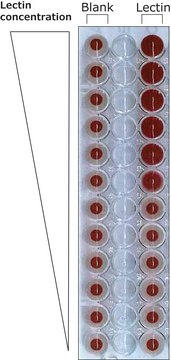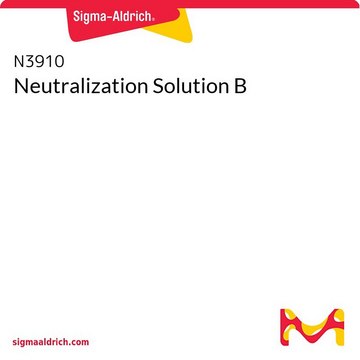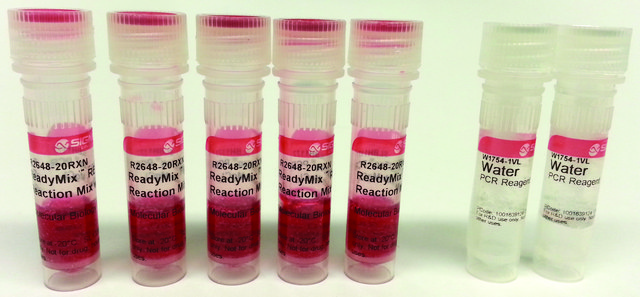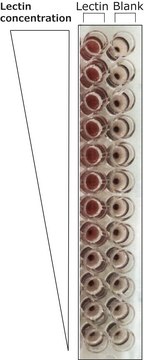L5264
Lectin from Bandeiraea simplicifolia (Griffonia simplicifolia)
TRITC conjugate, lyophilized powder
Synonym(s):
Bandeirea simplicifolia agglutinin, BS-I
Sign Into View Organizational & Contract Pricing
All Photos(1)
About This Item
UNSPSC Code:
12352200
Recommended Products
conjugate
TRITC conjugate
form
lyophilized powder
potency
<250 μg per mL agglutination activity (using human blood group A erythrocytes)
composition
Protein, ~10% Lowry
extent of labeling
1.5-3.5 mol TRITC per mol protein
storage temp.
−20°C
Looking for similar products? Visit Product Comparison Guide
Biochem/physiol Actions
BS-I has a major affinity for terminal α-D-galactosyl residues with a secondary affinity for terminal N-acetyl-α-D-galactosaminyl residues.
Other Notes
BS-I is a tetrameric lectin consisting of two types of subunits designated A and B. There are five BS-I isolectins with different subunit composition: BSI-B4, BSI-AB3, BSI-A2B2, BSI-A3B and BSI-A4. BSI-B4 is blood group B specific and has an exclusive affinity for terminal α-D-galactosyl residues, whereas BSI-A4 has blood group A specificity and has a major affinity for terminal N-acetyl-α-D-galactosaminyl residues.
Physical form
Contains phosphate buffer salts and sodium chloride
Analysis Note
Agglutination activity is expressed in μg/mL and is determined from serial dilutions of a 1 mg/mL solution using phosphate buffered saline, pH 6.8, containing, for each lectin, calcium, magnesium, and manganese at different concentrations. This activity is the lowest concentration to agglutinate a 2% suspension of appropriate erythrocytes after 1 hr incubation at 25 °C.
Storage Class Code
13 - Non Combustible Solids
WGK
WGK 3
Flash Point(F)
Not applicable
Flash Point(C)
Not applicable
Personal Protective Equipment
dust mask type N95 (US), Eyeshields, Gloves
Regulatory Information
新产品
Choose from one of the most recent versions:
Already Own This Product?
Find documentation for the products that you have recently purchased in the Document Library.
Devy Deliyanti et al.
Nature communications, 8(1), 748-748 (2017-10-01)
Neovascular retinopathies are major causes of vision loss; yet treatments to prevent the condition are inadequate. The role of regulatory T cells in neovascular retinopathy is unknown. Here we show that in retinopathy regulatory T cells are transiently increased in
Tracy M Hopkins et al.
Journal of biomedical materials research. Part A, 105(11), 3148-3158 (2017-08-07)
A current clinical challenge is to replace autografts for repair of injury gaps in peripheral nerves, which can occur due to trauma or surgical interruption. Biodegradable metallic magnesium filaments, placed inside hollow nerve conduits, could support nerve repair by providing
Tianwei E Zhou et al.
The American journal of pathology, 186(12), 3100-3116 (2016-10-22)
Retinopathy of prematurity (ROP), the most common cause of blindness in premature infants, has long been associated with inner retinal alterations. However, recent studies reveal outer retinal dysfunctions in patients formerly afflicted with ROP. We have recently demonstrated that choroidal
Stephanie Busch et al.
PloS one, 9(7), e102013-e102013 (2014-07-12)
Rats expressing a transgenic polycystic kidney disease (PKD) gene develop photoreceptor degeneration and subsequent vasoregression, as well as activation of retinal microglia and macroglia. To target the whole neuroglialvascular unit, neuro- and vasoprotective Erythropoietin (EPO) was intraperitoneally injected into four-week
Franziska Fischer et al.
Journal of neuroinflammation, 8, 120-120 (2011-09-29)
Retinal neovascularization has been intensively investigated in the mouse model of oxygen-induced retinopathy (OIR). Here, we studied the contribution of microglial cells to vascular regression during the hyperoxic phase and to retinal neovascularization during the hypoxic phase. Mice expressing green
Our team of scientists has experience in all areas of research including Life Science, Material Science, Chemical Synthesis, Chromatography, Analytical and many others.
Contact Technical Service